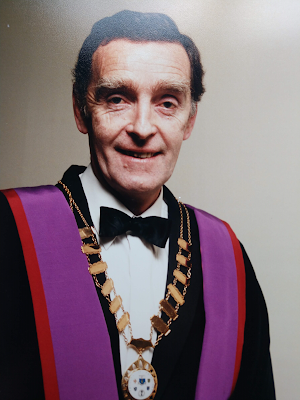Obituary: Professor Dermot Hourihane (1933-2020)
 |
| Prof Dermot Hourihane |
Dermot O’Brien Hourihane was born in 1933 and spent his early years in Ballina, Co Mayo where his father was County Medical Officer. The family moved to Dublin where he received most of his education. He graduated in medicine from University College Dublin in 1955. His training in pathology took place in London at the Royal Postgraduate Medical School and the Royal London Hospital where he published on coeliac disease and microangiopathic haemolytic anaemia. He received the MD degree for his work on asbestos and mesothelioma. He returned to Dublin in 1966 as reader in pathology at Trinity College and was appointed Professor of Pathology and Morbid Anatomy in 1973 and became a Fellow of Trinity College. He led the rationalisation of the laboratories of the seven small city-centre hospitals, the Federated Dublin Voluntary Hospitals (FDVH), and piloted their transfer to the new St James’s Hospital in 1981. He was consultant histopathologist at FDVH and at St James’s Hospital, head of the hospital histopathology department and also director of the Central Pathology Laboratory for several years. He was a founding fellow of the Faculty of Pathology of the Royal College of Physicians of Ireland in 1981 and was its second dean (1984-87). The Minister for Health appointed him to Comhairle na nOspidéal, the statutory body charged with regulating the number of consultant posts and the organisation and operation of hospital services. He was Dean of the Faculty of Medicine and Dentistry in Trinity from 1979-1983. He retired as Professor in 1998 but continued in histopathology practice for some years and maintained his connection with St James’s Hospital where he participated actively at weekly grand rounds until Parkinson’s disease finally slowed him down in his last few years and led to his death on 10 July 2020 aged 87 years.
He was a pre-eminent pathologist and a physician driven by a desire to improve the standard of medicine and the health services in Ireland. He was an early advocate of clinicopathological conferences (the forerunner of multidisciplinary team conferences) and lead regular death review conferences. In the Faculty of Pathology he pushed for the replacement of the general pathologist by specialists in the individual pathology disciplines (histopathology, microbiology, clinical chemistry, haematology and immunology). He advocated increased consultant staffing while on Comhairle, and developed strong professor-led departments in all the pathology disciplines at St James’s. He led a rigorous postgraduate training programme in histopathology and his undergraduate pathology course was a favourite with Trinity medical students.
He was no stranger to controversy. He confronted Archbishop John Charles McQuaid in 1970 on the issue of admittance of Roman Catholics to Trinity College. Around the same time he challenged the state’s restrictive laws on family planning and was one of a small group that formed the Irish Family Planning Association, a group which provided family planning services to the public and helped begin the process of liberalisation of Irish society. (On his retirement his colleagues presented him with a cartoon portrait that showed him putting an irate cleric under his microscope.) He opposed the proposed merger of Trinity with University College Dublin. Later, he was in the news when he disputed the pathological finding in the Fr Niall Molloy murder case. In his various administrative roles he was a scathing critic of inaction and vigorously opposed those whom he felt opposed improvement or stood in the way.
 |
Dermot Hourihane by Wendy Shea, 1998
|
Dermot was larger than life, enjoyed life to the full, indulging his passions for golf, gardening, bird watching, opera, cinema, good food and drink, and reveled in stimulating conversations across a broad spectrum of fields. His unfiltered observations around the department coffee table were an institution, and an education to those in training. A junior colleague noted his boyish smile, the sweet twinkle in his eye, his many kindnesses and his integrity.
He married Maura Brady in 1957. They lived in Monkstown, Co Dublin and had 4 children, Ann Marie, Deirdre, Jonathan and Paul, and 5 grandchildren. He was devoted to Maura; they loved to entertain and hosted memorable dinner parties. He will be remembered as a teacher, trainer, mentor, colleague and friend, as a leading academic and diagnostic pathologist, and a force for change in Irish pathology, and also for his broader contribution to Irish society.
Prof Sean O'Briain